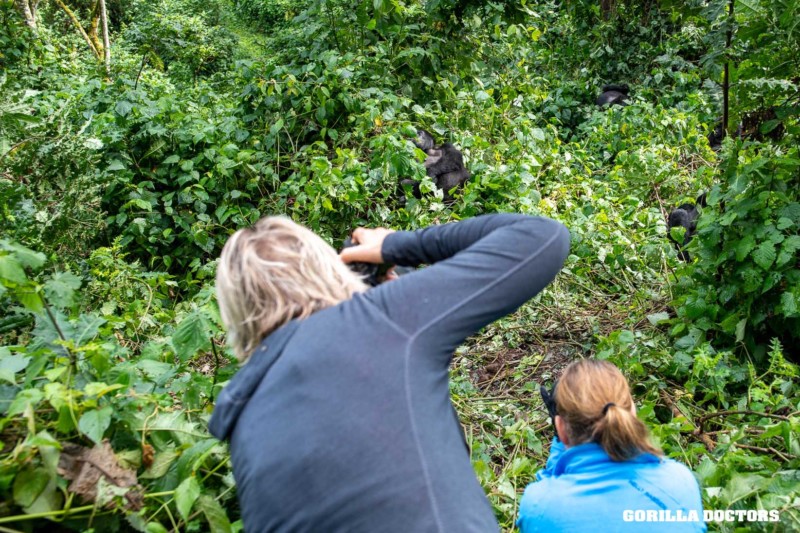Coronavirus and Disease: How You Can Help Protect Mountain Gorillas
By Gorilla Doctors Staff on Thursday, February 27th, 2020 in Blog.The Coronavirus (COVID) outbreak is naturally of serious concern and we have received some questions about eastern gorilla susceptibility to this novel virus. Gorilla Doctors has been on the forefront of research in emerging pandemic threats and zoonotic spillover for the past 10 years with our implementation of the USAID Emerging Pandemic Threats PREDICT project, including the identification of several known and novel coronavirus strains in wildlife.1 While to date there have been only two laboratory-confirmed human COVID cases on the African continent (in Algeria and Egypt), tourists are coming from around the world and visiting habituated gorillas daily. Gorilla Doctors is working closely with government wildlife authorities to mitigate the risks of (any) disease transfer from humans to gorillas and there are simple but highly effective actions tourists can also take to help protect endangered gorillas.

Tourists photograph mountain gorillas in Bwindi Impenetrable National Park, Uganda. Photo by Skyler Bishop. © Gorilla Doctors
Gorillas and Disease Transmission
Approximately 60% of the 1,063 mountain gorillas in the world are habituated to the presence of people (park personnel, tourists, researchers, veterinarians, etc.) to facilitate conservation, tourism, and research. These gorillas are in daily close proximity with people and are therefore uniquely at risk for contracting human pathogens.
It is currently unknown if great apes are susceptible to the SARS CoV-2 virus. However, great apes, including gorillas, are known to be susceptible to infection with human respiratory pathogens. In 2009, human metapneumovirus (HMPV) contributed to the death of two mountain gorillas during a severe outbreak of respiratory illness.2 This virus and others have also caused illness and death in wild chimpanzees.
You Can Help Protect Gorillas
The most effective measure for the prevention of the introduction of SARS CoV-2 virus (or any pathogen) to human-habituated eastern (mountain and Grauer’s) gorillas in Rwanda, Uganda and DR Congo is to minimize direct and indirect contact between gorillas and infected people.
If you are a tourist planning to visit gorillas, the following are the most effective actions you can take to protect them. While these measures may seem simple, they can have a significant impact on minimizing the transfer of infection while we are guests in their home environment:
- Follow tourism rules: maintain a distance of at least 10 meters (30 feet) from gorillas at all times. If the gorillas move closer to you, follow your guide’s instructions to move away. We understand the desire for closeness and even contact with these extraordinary animals, but even if you do not feel sick, it is possible you are carrying a virus or bacteria without exhibiting symptoms, so any contact could place the gorillas at risk.
- If you or anyone with you is sick (e.g. coughing, sneezing, feverish, suffering a sore throat) do not put the gorillas at risk by visiting them.
- If you have to sneeze or cough while in the presence of gorillas (even if wearing a mask), cover your mouth and nose with the crook of your elbow; do not use your hands. If you must use your hands, carry an alcohol-based hand sanitizer with you to disinfect immediately after.
Gorilla Doctors Supports Gorilla Tourism
Despite the risk of disease transmission to gorillas, responsible tourism is vital to the long-term conservation of these endangered animals. People have asked if it is better to leave the gorillas unhabituated, but science has shown that the level of protection and veterinary care that gorillas receive because they are habituated has made them the only great ape whose numbers in the wild are increasing.3
Gorilla Doctors’ hands-on veterinary work is possible only with human-habituated gorillas; we cannot get close enough to unhabituated gorillas to treat individuals, which means that in the event of a disease outbreak, Gorilla Doctors ability to help would be extremely limited. Having 60% of the mountain gorilla population habituated to the presence of humans means we can provide direct veterinary care in the case of illness or injury, and our work has been credited for half of the annual population growth rate of habituated mountain gorillas.3 And gorilla tourism, when safely and properly conducted, generates critical revenue for the parks, so that they can protect these endangered species. Gorilla Doctors supports responsible gorilla tourism and encourages tourists to be proactive in helping us minimize the risks of disease transmission.
References
1Nziza, et al. (2019). EcoHealth Online
2Palacios et al. (2011). Emerging Infectious Diseases 17: 711-713
3Robbins et al. (2011). PLoS One 6(6): e19788


 Donate
Donate